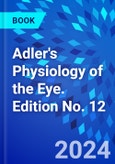- Covers the full structure and function of the eye and its related anatomy and makes the connection between physiology and clinical practice.
- Includes major updates throughout, including new information on OCT/OCTA imaging, new drug delivery methods, ocular biomechanics, and evolving gene therapies.
- Organizes content by function, rather than anatomy, to help you make a stronger connection between physiological principles and clinical practice.
- Explains the physiological principles that underlie visual acuity, intraocular pressure, ocular circulation, the extraocular muscles, and much more.
- Features approximately 1,000 illustrations throughout, including medical artwork; schematics, charts, and graphs; clinical photographs; and more.
- An eBook version is included with purchase. The eBook allows you to access all of the text, figures, and references, with the ability to search, customize your content, make notes and highlights, and have content read aloud. Any additional digital ancillary content may publish up to 6 weeks following the publication date.
Table of Contents
1 Optics
2 Optical Aberrations and Wavefront Sensing
3 Accommodation
4 Cornea and Sclera
5 The Lens
6 Vitreous
7 The Extraocular Muscles
8 Neural Control of Eye Movements
9 Three-Dimensional Eye Movements: Kinematics, Control, and Perceptual Consequences
10 Production and Flow of Aqueous Humor
11 Ocular Circulation
12 Metabolic Interactions Between Neurons and Glial Cells
13 The Function of the Retinal Pigment Epithelium
14 Functions of the Orbit and Eyelids
15 Formation and Function of the Tear Film
16 Sensory Innervation of the Eye
17 Outward-Directed Transport
18 Biochemical Cascade of Phototransduction
19 Photoresponses of Rods and Cones
20 Light Adaptation in Photoreceptors
21 The Synaptic Organization of the Retina
22 Signal Processing in the Outer Retina
23 Visual Processing in the Inner Retina
24 Electroretinogram
25 Regulation of Light Through the Pupil
26 Ganglion-Cell Photoreceptors
27 Overview of the Central Visual Pathways
28 Optic Nerve
29 Processing in the Lateral Geniculate Nucleus
30 Primary Visual Cortex
31 Extrastriate Visual Cortex
32 Visual Processing of Spatial Form
33 Visual Acuity
34 Color Vision
35 The Visual Field
36 Binocular Vision
37 Temporal Properties of Vision
38 Development of Vision in Infancy
39 Development of Retinogeniculate Projections
40 Developmental Visual Deprivation
41 The Effects of Visual Deprivation After Infancy








